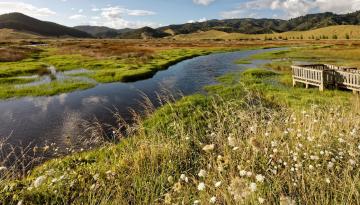
Nitrogen can hide no longer - a new interactive map has been launched to show which rivers, lakes and estuaries are under pressure from agriculture.
Swiping left on the map shows total nitrogen levels in excess of regulatory rules, while swiping right reveals what might happen if nitrogen levels reduce in years to come.
AgResearch's principal scientist professor Richard McDowell said the map showed nitrogen loads exceeded regulations in nine out of 15 regions.
That included parts of Waikato, Manawatū-Whanganui, Marlborough and Canterbury.
"There will be some places that may not be able to meet those regulatory limits and I guess our hope is that the map can help people start thinking about what lower intensity land uses could apply in those areas," he said.
He said the information was critical to farmers in catchments with high nitrogen levels and could help them decide whether to continue investing in mitigation actions or consider making changes to land use.
High nitrogen levels in water can increase algae growth and make water unswimmable and undrinkable.
While many waterways are badly polluted, the map showed that without efforts by farmers to mitigate runoff, the problem would be much worse.
Dairy NZ strategy and investment leader Dr David Burger said widespread improvements had been made by farmers in the last 25 years.
"So for dairy specifically, we know that nitrogen would have been 45 percent higher... between 1995 and 2015 across individual farms if those mitigations hadn't been carried out," he said.
He said the Government's policies allowed for changes over a generation and regional councils were now working with iwi and local communities to define how nitrate standards would be met.
Choose Clean Water spokesperson Marnie Prickett was not surprised by the data, but said it highlighted the need for the Government's fertiliser cap due to take effect next year.
"We've got some people applying quite extreme levels of nitrogen fertiliser up to 375kg. Really, that's excessive - it's not needed for any economic reason - and so we can bring that down to that 190kg-per-hectare-per-year cap in a very short term," she said.
She said it would help the climate as well as the waterways. Parliament declared a climate emergency last week.
Prickett said the rural sector needed to show some strong leadership about making improvements across the board.
"We need to hear from those agricultural leaders that we are now on a path to de-intensification - that we are on a path to putting the health of our environment first so that it can support our people.
"That leadership really needs to come from the agricultural industry because what they do when they don't put that message out is they override the work of those farmers that are trying to do the right thing," she said.
RNZ


